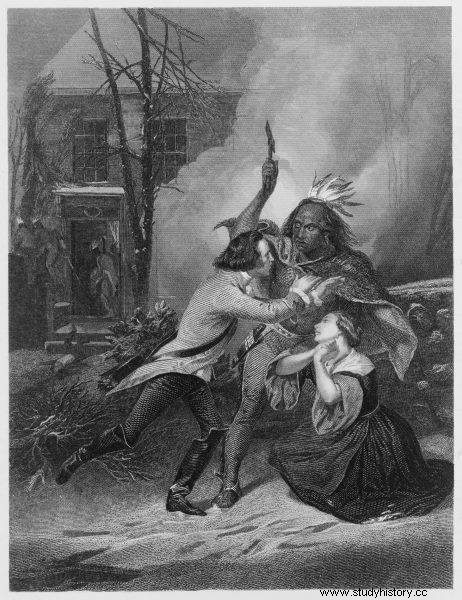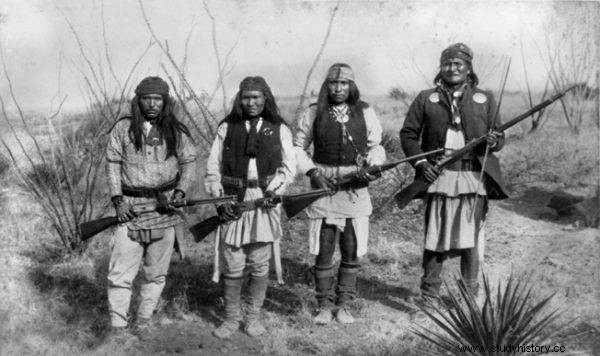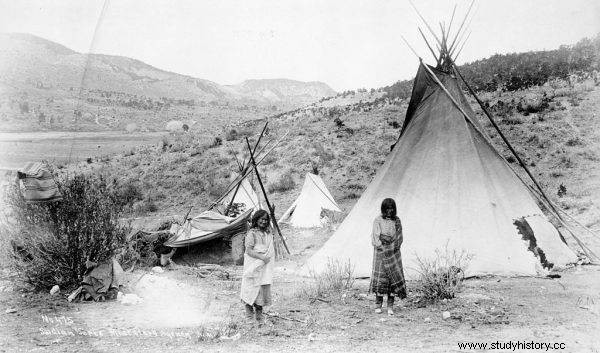Honest, just, willing to forgive and help the oppressed, fighting fair and not attacking the defenseless - this was Winnetou, son of the chief of the Apache tribe and the main character of the Charles May book series. It is this writer who is largely responsible for the dissemination of the idealized image of the indigenous people of North America in the mass imagination. However, the reality was quite different ...
The white colonizers of the American continent judged the Indians much more severely. They were widely feared. The cruelty, rituals and way of being of the tribes disgusted and terrified Europeans. Children were frightened with Indians, and stories of their bestialities stood on their heads.
Pure evil
“They tore my poor son off my breast […]. They took our little children, put them on a spit, held them over a fire and baked them in front of our eyes ”- this is one of the memories of the Iroquois, famous for their aggression and love of war. There are many more similar accounts of the pioneers who inhabited the New World in the 17th and 18th centuries:
both Frenchmen ripped their clothes off […] painted their faces in the native fashion. Then the enemy [the villagers] prepared to greet them - which meant forcing the captives to pass between two rows ["hosts"], each offering a punch with a stick [...] they were led to the central part of the village, where they were ordered to climb a specially prepared scaffolding. There, one of the Iroquois grabbed a stick and hit René seven or eight times and pulled out his fingernails.
The brutal abuse of prisoners by all the villagers was a typical course of action for the Iroquois. The unfortunates became the "main attraction" of this sophisticated spectacle. Captured enemies had their fingers snapped off and then taken to a settlement. Before that, messengers had reached her, informing about the number of the captured. In order to "greet" them, the townspeople lined up in two rows with sticks in their hands. Every prisoner had to pass through such a corridor. During this time, he was mercilessly beaten. Later, his clothes were torn off and he was led to the center of the village - to the stage where the "show" was taking place.

photo:public domain Colonists from Europe scared children with stories about Indian cruelty
If the war expedition was in retaliation for the deaths of the Iroquois, matrons of the families who suffered loss would choose those captives to be assimilated and (literally) to replace the dead. It was believed that the spirits of the dead would become slaves - in this way the tribe equalized the personal status.
Those who were not so lucky died in torment. With the sound of drums, the wailing of shamans, dances and burning herbs their nails were torn off, burned with hot heads, bones and teeth were broken, flaps were torn out, parts of their faces were cut off . The torture could go on for hours. The idea was to inflict as much pain on the victim as possible. Before his death, the unfortunate man had his scalp removed. The bleeding open skull was sprinkled with ash or sand. When the enemy finally died, his flesh was separated from his bones, then cooked and eaten at ritual feasts. In view of such descriptions, is it any wonder that the Europeans saw pure evil in the Indians?
Women had a better chance of survival. They were often raped many times, but less often killed. They could become slaves in the Indian camp or marry one of the warriors. Children who had been prepared to live in the Indian world were also spared. Those slaves who did not die during the torture and were not assimilated could go back to the whites - as long as someone bought them out.
“[Comanche] gather in the market and offer the captives for sale. If a captive is a woman, she is first raped by her owner in front of everyone. Then the warrior says to the buyer:now you can take it, now she is good, "recalled Fray Andres Varo, one of the missionaries in North America.
Assassins and Highwaymen
Karol May painted the figure of Winnetou imbued with an almost chivalrous ideal of confrontation on an equal footing - without backstabs, fraud and assassination, face to face on the battlefield. In the eyes of Europeans, however, the cruel Indians were not like the Winnetou. They were considered cheaters and highwaymen who did not fight fair.
Many tribes loved ambushes and surprise attacks. Despite cultivating the ethos of a warrior, whose goal was to show bravery in combat and bravely endure pain, Native Americans did not go into battle when it did not pay them off or when defeat was real. They calculated their chances very carefully before going into battle. Bartosz Hlebowicz, author of the study “Cruelnier than tigers. The art of war, torture, dreams and myths of the Iroquois ”, he writes:
They also did not appreciate "death on the field of glory" as the whites did - in the face of the advantage of the enemy or even the events that bore the success of the expedition, they preferred to withdraw and negotiate even unfavorable truce conditions than die. They preferred to "wage war in secret" to open battles, for example they could hide behind tree trunks or in pits dug in the ground for two or three days, having nothing to eat, waiting for an opportunity to surprise the enemy. Having seized a few prisoners, they withdrew, considering the expedition a success.
Europeans viewed the natives as procrastinators who avoid fair confrontation unless they are clearly outnumbered - or among their enemies there is no shortage of old people, women and children. Memories of the colonists are full of brutal descriptions of Indian raids on ordinary people, farmers, living in peace in their homes.

There were plenty of bloodthirsty warriors among the Indians (Geronimo and his companions in the photo)
In 1860, several hundred Indians from the Kiowa and Comancz tribes set off to slaughter the Texas inhabitants. The natives broke into houses, dragged entire families out of them, cruelly tortured and killed. Such a fate befell, among others closest settler named Sherman. They were mugged during dinner. They had no chance against the vast majority of torturers. They were dragged outside. Sherman's wife was raped in front of their son. Then one of the Indians tried to remove the scalp from her head. Failing that, he tied her hair to a ponytail and began tugging it behind him until he ripped a flap of skin off her skull. The woman died in agony, additionally wounded by arrows from bows.
The Apaches, from whom the heroic Winnetou descended, were also famous for their refined cruelty. One of the "games" with the participation of prisoners was seemingly releasing them slowly, but with tied hands. Then "hunts" were organized with women participating. The fugitive had no chance to defend himself. If he didn't get away, he was slaughtered with pikes, tomahawks, and clubs by bloodthirsty Indian women. Sometimes he has been scalped alive, his genitals have been cut off and harassed in various other ways.
The Europeans were also shocked by the extremely frequent practice of desecration among Indians. An example is the invasion of the Comanche on the Spanish San Saba mission in Texas in 1758. After the slaughter of the inhabitants, the invaders desecrated the local church, incl. they cut off the head of the statuette of Saint Francis. Then they "took care" of the bodies of the dead. They took off their clothes, scalped them and gouged out their eyes. As they departed, they demolished and set fire to the buildings. They also left behind the dead bodies of animals in the fields. The cattle were fired for fun.
An Indian, a thief?
Theft is one of the crimes particularly stigmatized in European culture. The visitor from the Old Continent, who was not aware of the cultural conditions of the indigenous Indians, simply saw them as thieves. The redskins specialized in the abduction of pale-faced flocks. The kidnapping of cattle and horses was a real scourge faced by the colonizers of the Great Plains . The Comanche, who were called devils for a reason, were especially the leaders. Mothers scared crying children with them…
However, the theft of cattle in the eyes of the Indians was not a disgrace, and a reason to be proud - it was a confirmation of the warrior's efficiency and cunning. It was also part of the eternal rivalry between the tribes. Bartosz Hlebowicz writes:
As calculated by Iroquois historian José António Brandão, between 1603 and 1701 the Iroquois were attacked by at least twenty different tribes or Indian confederations and themselves raided fifty-one different indigenous communities. During this period, they took part in at least four hundred and sixty-five clashes, and in three hundred and fifty-four of them they were aggressors.
In such a world, cruelty was the norm. Although it shocked the people of that time and still shocked today, we will not understand the brutal reality of the Indians without referring to their worldview and beliefs, in which struggle and suffering were a very important element. Hlebowicz comments:
Perhaps it would bring us closer to understanding the essence of Iroquois cruelty by realizing this amazing fact: in certain situations the Iroquois were ready to inflict almost the same cruelty on themselves. The interpretations of dream visions were decisive for the torture inflicted on tribesmen, which could even result in death.
The dance of the spirit
Today, cultural anthropologists and ethnologists who look at Indian customs are able to "decode" the meaning of brutal torture. They performed the function of strengthening the unity and cohesion of the tribe. During the colonization of America, hardly anyone was able to look more broadly and try to understand the world of the indigenous people of the continent. Indian cruelty, violence, raids, torture, rape, desecration of corpses - all this served to justify increasing harassment, more and more frequent acts of violence, genocide, fraud and expropriation of local people from their own land by white colonizers and the American state.
Those who saw in the natives only bloodthirsty, cruel savages, those who often had the love of their neighbor on their lips, in the end turned out to be bloodthirsty beasts themselves. On November 29, 1864, 700 soldiers of Colonel John Chivington of Colorado opened fire on 200 Cheyenne and Arapahs from the Sand Creek encampment, mostly old men, women, and children. The intervention turned into a slaughter. The soldiers pulled the scalps off the heads of the Indians, tore the bellies of pregnant women, cut off the noses and ears of the victims, and gouged out the eyes . They also hunt for the youngest boys. The target of the shooting competition was a three-year-old child.

It is impossible to understand the cruelty of the Indians without taking into account their worldview and beliefs
Decimated by disease and wars, famine and the disintegration of natural tribal structures due to the destruction of buffalo herds, the reserved native peoples of America looked for hope - some in vodka, others in the promises of shamans. In the late 1800s, those on Dakota reservations began to spread faith in the coming white apocalypse that would allow the Indians to regain land and dignity. To this end, they indulged in the dark "dance of the spirit", a kind of prayer intended to bring the buffalo back and drive out the visitors from overseas.
On December 29, 1890, in the Lakota village on the Wounded Knee stream, the army tried to enforce the ban on these dances. However, the situation got out of hand. The army began firing at the reserve's defenseless inhabitants. Several hundred Indians were murdered, including many women and children, as well as the Greatfoot chief. Colonel James Forsyth, commanding the army that perpetrated the massacre, escaped responsibility despite being indicted. Public opinion was on his side, more or less openly expressing the view that the Indians "deserved" what had happened to them.
Some have directly called for the "final solution" of the Indian question. Among those who demanded a ruthless deal with the natives, there were, among others L. Frank Baum, later author of the The Wizard of Oz . In columns for the press, he expressed an appeal for: "complete annihilation of the few remaining Indians and the clash of these unrestrained and unrestrained creatures from the face of the earth."
The American state was also reluctant to make up for the Lakota's losses, despite the fact that General Nelson Miles tried to do so until the end of his life. However, he did not find a hearing in the ranks of the army and in congress. The Sand Creek Massacre brings the white colonialist-indigenous peoples to an end. The latter have lost the clash of civilization. The former, though renouncing violence and cruelty, ultimately prepared a cruel fate for millions of natives. They took their land and dignity from them. They destroyed their entire world.
Bibliography:
- Anna Czyż; To cross the taboo. Cases of cannibalism in New France , "Tawacin", R. 62 (2003), No. 2, pp. 13-21.
- Anna Czyż; Jesuit accounts as the basis for shaping the image of the Indian in the European consciousness of the 17th and 18th centuries , "Tawacin", R. 53 (2001), No. 1.
- Rene Girard; Sacrum and violence , trans. M. and J. Plecińscy, Gate - Library of Włóczęgów i Schych, Poznań 1994.
- B. Hlebowicz, More cruel than tigers. The art of war, torture, Iroquois dreams and myths , "Laboratorium Kultury" 4 (2015), pp. 263-316.
- Leszek Michalik; Encyclopedia of North American Tribes , Publishing House Miniatura 2009.
- Jarosław Wojtczak; Apache. The human tigers, Napoleon V 2019 publishing house.
- Jarosław Wojtczak; Indians and pale faces. Clash of civilizations , Bellona 2017.
